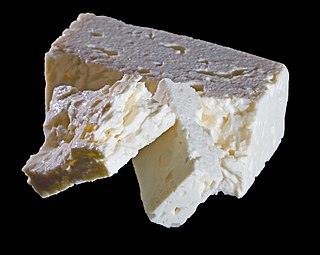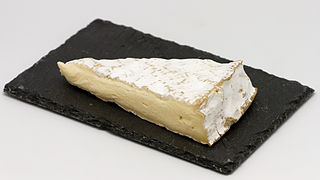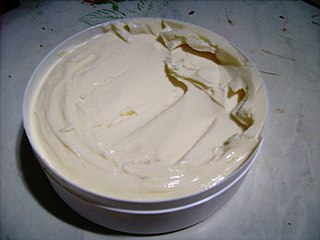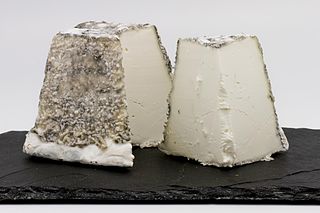
Monterey Jack, sometimes shortened to Jack, is a US white, semi-hard cheese made using cow's milk, with a mild flavor and slight sweetness. It has been called "an American original" and "as a vestige of Spanish rule in the early nineteenth century, derives from a Franciscan monastic style of farmer's cheese."

Feta is a Greek brined white cheese made from sheep's milk or from a mixture of sheep and goat's milk. It is soft, with small or no holes, a compact touch, few cuts, and no skin. Crumbly with a slightly grainy texture, it is formed into large blocks and aged in brine. Its flavor is tangy and salty, ranging from mild to sharp. Feta is used as a table cheese, in salads such as Greek salad, and in pastries, notably the phyllo-based Greek dishes spanakopita "spinach pie" and tyropita "cheese pie". It is often served with olive oil or olives, and sprinkled with aromatic herbs such as oregano. It can also be served cooked, as part of a sandwich, in omelettes, and many other dishes.

Bel Paese is a semi-soft Italian cheese. It was invented in 1906 by Egidio Galbani who wanted to produce a mild and delicate cheese to sell mainly in Italy. The name Bel Paese comes from the title of a book written by Antonio Stoppani. It is Italian for "beautiful country", and is used as a phrase for Italy itself.

Paneer, also known as ponir, is a fresh acid-set cheese common in the Indian subcontinent made from full-fat buffalo milk or cow milk. It is a non-aged, non-melting soft cheese made by curdling milk with a fruit- or vegetable-derived acid, such as lemon juice.

Brie de Meaux is a French brie cheese of the Brie region and a designated AOC product since 1980. Its name comes from the town of Meaux in the Brie region. As of 2003, 6,774 tonnes were produced annually.

The milanesa is a variation of the Lombard veal Milanese, or the Austrian Wiener Schnitzel, where generic types of meat breaded cutlet preparations are known as a milanesa.

Cantal cheese is an uncooked firm cheese produced in the Auvergne region of central France: more particularly in the département of Cantal as well as in certain adjoining districts. Cantal cheese was granted Appellation d'Origine Contrôlée certification in 1956. One of the oldest cheeses in France, Cantal dates back to the times of the Gauls. It came to prominence when Marshal Henri de La Ferté-Senneterre served it at the table of Louis XIV of France. Senneterre is also responsible for the introduction of Saint-Nectaire and Salers.
Caș is a type of semi-soft white fresh cheese produced in Romania. It is made by curdling sheep or cow milk with rennet, and draining the whey. The resulting cheese is unsalted or lightly salted. If stored in brine, caș turns into Telemea after 2–3 weeks.

Catupiry is one of the most popular brands of requeijão cheese in Brazil. It was developed by Italian immigrant Mario Silvestrini in the state of Minas Gerais in 1911. The name derives from the Tupi word meaning "excellent".

Langres is a French cheese from the plateau of Langres in the region of Champagne-Ardenne. It has benefited from an Appellation d'origine contrôlée (AOC) since 1991.

Mimolette is a cheese traditionally produced around the city of Lille, France. In France it is also known as Boule de Lille after its city of origin, or vieux Hollande because it was originally inspired by the Dutch Edam cheese.

Chabichou is a traditional semi-soft, unpasteurized, natural-rind French goat cheese with a firm and creamy texture. Chabichou is formed in a cylindrical shape which is called a "bonde", per the shape of the bunghole of a wine barrel. and is aged for 10 to 20 days. It is the only goat cheese that is soft ripened allowed by Protected Designation of Origin regulations to be produced using pasteurized milk. Chabichou is very white and smooth, and flexible to the palate, with a fine caprine odor.

A pebete is an Argentine and Uruguayan soft oval bun made of wheat flour with a thin brown crust, rather like a fatter hot dog roll. It is often used to make a sandwich, typically filled with cheese, cured meat, tomato and mayonnaise; the sandwich itself is usually called pebete followed by its filling, e.g., pebete de queso.

There are many different types of cheese. Cheeses can be grouped or classified according to criteria such as length of fermentation, texture, methods of production, fat content, animal milk, and country or region of origin. The method most commonly and traditionally used is based on moisture content, which is then further narrowed down by fat content and curing or ripening methods. The criteria may either be used singly or in combination, with no single method being universally used.

Quince cheese is a sweet, thick jelly made of the pulp of the quince fruit. It is a common confection in several countries.

Argentine cheese is by far the most produced dairy product in the country, making Argentina the second largest cheese producer in Latin America and among the top 10 cheese-producing countries in the world. In addition, Argentina is the Latin American country that consumes the most cheese, with 12 kilos per capita per year. Production is mainly centered in the provinces of Córdoba, Santa Fe and Buenos Aires, in the Pampas region of the central and east-central parts of the country.















